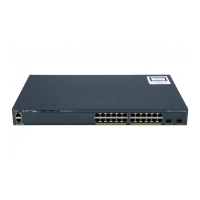Chapter 6
VLANs and Trunking
See the following sections for configuration information about these topics:
■ 6-1: VLAN Configuration: Describes the method for configuring, creating, and con-
figuring VLANs on a switch
■ 6-2: VLAN Port Assignments: Explains how to assign a port to a VLAN using static
or dynamic methods
■ 6-3: Trunking: Covers the method for extending a VLAN beyond the boundaries of
a single switch through tagging mechanisms
■ 6-4: VLAN Trunking Protocol: Describes the Cisco proprietary protocol for main-
taining a forwarding path between switches that are trunking and how to prune for
unused VLANs
■ 6-5: Private VLANs: Explains the feature that allows for more granular traffic control
within the VLAN using the private VLAN structure
6-1: VLAN Configuration
■ VLANs are broadcast domains defined within switches to enable control of broad-
cast, multicast, unicast, and unknown unicast within a Layer 2 device.
■ VLANs are defined on a switch in an internal database known as the VLAN
Trunking Protocol (VTP) database. After a VLAN has been created, ports are
assigned to the VLAN.
■ VLANs are assigned numbers for identification within and between switches. Cisco
switches have two ranges of VLANs, the normal range and extended range.
■ VLANs have a variety of configurable parameters, including name, type, and state.
■ Several VLANs are reserved, and some can be used for internal purposes within the
switch.

